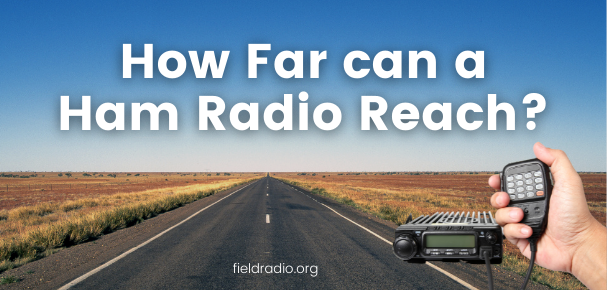A Ham radio is often one of the first things to go in a survivalist’s SHTF bag.
And it makes sense.
This radio won’t give up on you when you need it the most, unlike that smartphone you love so much.
But merely having a Ham radio does not and cannot complete your survivalist kit. When S actually HTF, you will need to know which way to move the dial or what numbers to punch in for the radio to serve its purpose.
So, I have gathered the important Ham radio prepper frequencies you can use in TEOTWAWKI or SHTF situations and I’ll be sharing them with you in this blog.
Be sure to read till the end so you don’t miss out on some important survivalist information.
Ham radio prepper frequencies to know:
- 146.52 MHz. (2m simplex)
- 446 MHz., (70 cm simplex)
- 146.42 MHz.,
- 146.55 MHz.,
- 14.325 MHz.,
- NOAA frequencies
- FEMA frequencies
Who Are Preppers and Why do they Use Ham Radio?
Preppers or survivalists are people who prepare for SHTF (meaning Shit Hits The Fan) and TEOTWAWKIkind of situations. They anticipate and prepare for surviving in unusual scenarios either caused due to or resulting in “the end of the world as we know it.”
Preparing for unprecedented situations that would demolish or disable the modern communication system, preppers don’t rely on mobile phones or the internet to keep them connected.
Instead, they look for communication equipment such as a ham or GMRS radio that operates independently and prefer devices that can send or receive messages even if telephone towers are down and internet lines are disconnected.
Since Ham radios are independent of modern communications infrastructure, they make for the perfect emergency communication equipment for these preppers.
Typical Ham radios are mostly battery-operated. They can have a range of 2-18 miles without using repeaters and on normal power in the VHF and UHF range. And with Ham radio repeaters, this range can increase significantly.
Therefore, Ham radios promise to keep preppers connected in case everything goes down. Hence, they enjoy such popularity in the survivalists’ circle.
What Frequencies do Preppers Use?
Like everything in the Ham radio universe, there’s no straightforward answer to this question. Yes, there are some general Ham radio prepper frequencies that can help you get the information you need during emergencies. But apart from these frequencies, preppers from different states and counties tune in to various frequencies to get help.
I’ll share the general frequencies here first, and then we will dig into further details.
Ham Radio Prepper Frequencies – The General Ones
The 2m simplex frequency at 146.52 MHz is one of the most common Ham radio prepper frequencies you can tune in to if you cannot think of anything else. This frequency is almost always being monitored by someone and offers a better chance of your call being heard. Apart from this, there’s the 70cm simplex frequency as well at 446 MHz.
You can keep these two frequencies in mind and program them before anything else.
Apart from these, some Ham radio operators list 146.42 MHz as one of the Ham radio prepper frequencies, but this may vary depending on where you live.
If you are looking for prompt weather updates in scary weather situations, 146.55 MHz. is said to be the most used frequency by storm chasers as they communicate with other authorities. You can get live weather updates from this one.
Besides these general frequencies, there are some national prepper frequencies that should be programmed in every survivalist’s radio.
Let’s see what these are next.
Ham Radio Prepper Frequencies – The National Ones
The NOAA weather channels are some of the most recommended prepper frequencies. NOAA broadcasts weather warnings and information via one or all of these frequencies 24 hours a day.
These frequencies include:
- 162.4 MHz
- 162.425 MHz
- 162.45 MHz
- 162.475 MHz
- 162.5 MHz
- 162.525
- 162.550 MHz
Besides NOAA, Federal Emergency Management Agency (FEMA) also has some dedicated frequencies that you can monitor for essential updates.
You can conveniently find these FEMA frequencies on radioreference.com here.
Even though the NOAA and FEMA frequencies fall out of the dedicated Amateur radio bands, most modern ham radios can pick up these signals. So, depending on your device, you should be able to listen to them during emergency situations.
Salvation Army Team Emergency Radio Network or SATERN is another radio service that offers voluntary communication services during emergencies. You can reach SATERN on 14.325 MHz. and get help from one of their volunteers, if your radio is capable of transmitting on the 20m band.
Ham Radio Prepper Frequencies – The Varying Ones
Apart from NOAA and FEMA, there are many other organizations, like SKYWARN that send information out on Ham bands.
SKYWARN is a network of volunteers who provide timely and accurate information to the National Weather Service or NWS. SKYWARN’s frequencies are a reliable source of information, especially when looking for critical weather updates. But they vary from locality to locality.
For example, Alabama has SKYWARN repeaters operating on 145.43 MHz. for wide coverage from northern Tuscaloosa county, while it operates on 146.79 MHz. for Henderson, Kentucky.
Similarly, storm chasers and emergency management agencies may also operate on different frequencies, depending on the state.
Kentucky Storm chasers are reported to operate on 3 UHF channels, including 440.5 MHz., 441.025 MHz., and 442.125 MHz. Alabama storm chasers, on the other hand, operate on 145.79 MHz. and 441 MHz.
Apart from these weather-emergency frequencies, your local nets can also serve as Ham radio prepper frequencies for you.
Additionally, many prepper Ham radio operators also recommend knowing and programming your local repeater frequencies. Many repeaters work on either solar power or generators and can provide wider coverage, which can come in handy during SHTF situations.
But how do you find all these frequencies? I’ll tell you just that in the next section.
How to Find the Right Ham Radio Prepper Frequencies?
You know from above how Ham radio prepper frequencies vary from state to state and county to county. Now I’ll tell you how to find the right prepper frequencies for your area.
Radioreference.com has one of the most extensive radio frequencies databases. You can log on to their website, create an account (it’s free, and anyone can get one), and retrieve a list of all amateur radio frequencies in your area by searching either your state or your county.
For local repeater frequencies, you can check out the database at repeaterbook.com. This website has a list of Ham radio repeaters categorized according to state. Just find your state, click on it, and see if you can find any repeaters close to your station.
Finally, I also recommended knowing and joining your local Ham clubs or nets.
ARRL has a vast directory of all registered Hams that you can access simply by entering your state and a net category. From there, you can find out if there are any nets in your area and join them to learn about your local Ham radio prepper frequencies and more.
Now that you know what prepper Amateur frequencies to use and how to find them, let me address an important matter.
What Ham Radio Prepper Frequency Can You Use without a License?
What Ham radio prepper frequency you can use without a Ham radio license depends on what you are using the frequency for.
If you are just tuning in just to listen, you can monitor whatever frequencies you like.
But if you want to transmit as well, unlicensed transmission via a Ham radio is illegal and can get you in some serious trouble.
Therefore, there are NO Ham radio prepper frequencies you can use for broadcasting if you don’t have a license.
However, there is an exception to this…
Unlicensed Ham radio transmission can be permitted if you are in a life or death emergency and there are no other sources of communication available.
In that circumstance, you can hop on any frequency you think someone will listen to and ask for help.
Final Word
Choosing a Ham radio for your SHTF inventory is a great idea. But unless you program the right Ham radio prepper frequencies in it, the radio may not be able to do you much good.
Therefore, you must know at least some prepper frequencies for your survival kit to be complete.
However, knowing all the prepper frequencies, while being a step in the right direction, isn’t enough.
Just like having a car sitting in your garage does not mean you will be able to drive it in an emergency, having a Ham radio with prepper frequencies in your SHTF bag does not guarantee you will be able to use it to get help when the situation does go bad.
Therefore, learn how to use a Ham radio, get yourself licensed, and continue practicing your radio communication skills so you can use an amateur radio properly when the time comes.

I have been passionate about the world of communications in its various forms for most of my life. Ever since I first found an old ham radio stashed away in my uncle’s attic, I have had a fascination with this classic technology.
Having the ability to communicate with people without the need to rely on telephone lines or networks is an empowering feeling which I believe everyone should have at least a basic knowledge of. Becuase who knows when you might need it?
I setup fieldradio.org with this passion in mind, to help inform people about the amazing possibilities of amateur radio and I’m on a quest to help educate as many budding operators as possible.
I hope you enjoy our content. Come and say hi, via our contact form


